Map to show you safest way home developed by computer scientists to save lives

A digital map which shows you the safest way to get home, rather than just the quickest, has been developed by Cardiff University to stem the rise in pedestrian deaths.
Pedestrians now make up a quarter of all deaths on the road, and most recent Department of Transport figures show that some 448 people were killed in 2016, a rise of 10 per cent in a year.
Now maths and computer scientists have developed algorithms which can predict where accidents are most likely to occur based on types and number of crossings, speed limits and probability of people making a quick dash across a road.
In a new study, published in the journal Accident Analysis and Prevention, they showed they can give each street a safety score and successfully predict how many road casualties are likely in an area.
They now plan to turn the project into an app which can be downloaded so people can choose the safest way home.
Lead author of the study Dr Padraig Corcoran, from Cardiff University’ School of Computer Science and Informatics, said: “The aim of the study was to devise a novel way of tackling the rising number of pedestrian casualties that are occurring on our roads each year.
“Google Maps is used millions of times a day to get people from A to B, yet it completely overlooks the safety of the routes that it offers to pedestrians.
“Considering the large amount of deaths caused each year by road traffic crashes, we decided to devise a way of mapping how safe a particular road is by using a wide range of variables, such as the number of crossings and the speed limit of the road.
“We know that our safety ratings are accurate as they directly correlate with the number of road casualties in a given area.”

The new system has already been tested on 15 British cities – Bath, Bedford, Blackpool, Bristol, Coventry, Leeds, Leicester, Liverpool, Manchester, Nottingham, Reading, Salford, Sheffield, Swindon and York.
Of those 15 cities, Liverpool was ranked as having the most unsafe roads whereas Bath was deemed to have the safest.
The researchers believe the maps could also be useful to city planners and developers when assessing how changes to infrastructure may affect road safety, such as the pedestrianizing of roads or the changing of speed limits.
In the nearer term, the team are looking at developing an app which people could use to tell them the safest possible route to their destination.
“Our next aim is translate this research into a product that the public can use,” added Dr Cocoran.
“We envisage something very similar to Google Maps in which a user can input their destination and then choose a route that utilises our algorithm and gives them the safest possible journey instead of the quickest.
“This could definitely save lives and would go some way to reducing the high levels of causalities both here in the UK and across the world.”

 Yahoo News
Yahoo News 
